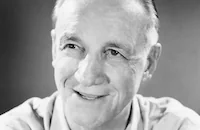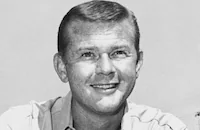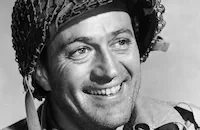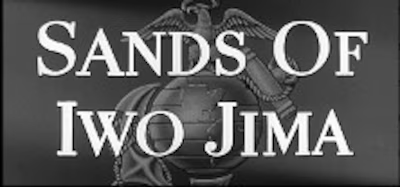Sands of Iwo Jima

Brief Synopsis
Cast & Crew
Allan Dwan
John Wayne
John Agar
Adele Mara
Forrest Tucker
Wally Cassell
Film Details
Technical Specs

Synopsis
At a New Zealand Marine base in 1943, Corporal Robert Dunne recounts his first tour of duty: Before Dunne and his friends, Italian-American Benny Regazzi, Greek-American George Hellenopolis, Polish-American "Ski" Choynski, Jewish-American Sid Stein, two Irish-American brothers named Flynn, and Dan Shipley and Charlie Bass, meet their battle-hardened commander, Sgt. Stryker, they learn of his infamous toughness and mysterious demotion. One morning early in the training period, Stryker discovers that Peter Conway, the son of his deceased former commanding officer, Col. Sam Conway, has joined his unit. Although Stryker attempts to bond with Pete over Sam's memory, Pete reveals that he hated his demanding father and also despises Stryker for his resemblance to the man. When the mail arrives later, Stryker is saddened to find no letter from his own son, of whom his wife took sole custody when she left him five years earlier. After finally receiving some leave time, Stryker's men decide to visit a dance hall.
There, Pete meets and falls in love with Allison Bromley and Stryker drinks to excess. A few days later, Stryker urges Pete not to become too attached to Allison and then sympathetically overhears him discussing his desire to procreate in the face of all the death around him. Only a day after Pete and Allison marry, the unit is sent to the Tarawa atoll, which is occupied by Japanese forces. After Stryker's unit lands, he orders two of his men to cross a dangerous minefield and place a charge inside a bunker where the Japanese have hidden some explosives. Stryker watches as both men are shot down, then rushes forward to grab the charge and complete the mission single-handedly. Later, Corp. Al Thomas decides to take a coffee break in the mortar men's foxhole, while leaving his subordinates, Bass and Hellenopolis, alone in theirs. This move inadvertently causes Hellenopolis' death and Bass's wounding.
The unit is then ordered to entrench, without movement, in an unsafe zone, and despite the pleas of his men to rescue the nearby Bass, Stryker refuses to violate his orders, and they are forced to listen to Bass's plaintive cries for help until the next morning, when Bass is rescued. Later, the unit arrives in Hawaii, where Bass tells Stryker that Thomas was absent from his post during the attack. Stryker immediately starts a fight with Thomas, and when a major demands to know who started it, Thomas, realizing that another demotion could end Stryker's career, protects his sergeant. He then tells Stryker of his deep guilt and remorse, after which Stryker forgives him. Soon after, Pete learns that Allison has given birth to a son, news which secretly pleases Stryker.
While on leave in Honolulu, Stryker goes home with a woman forced into prostitution to care for her baby son and realizes that he has been wallowing in self-pity over the loss of his family for too long. Later, during grenade training, Stryker saves Pete's life. Soon after, the unit ships out and is ordered to complete a difficult landing on the rocky, island cliffs of Japan's Iwo Jima. The fighting is intense, with many of the unit's men dying, and although Pete is afraid he will die, he saves Stryker's life and reveals to him that he plans to name his son Sam after his father.
When the unit finally gains the top of the island's Mount Suribachi, Stryker instructs his men to hoist the American flag, but is killed by a random bullet. Pete drops to his knees to embrace Stryker's corpse and finds an unfinished letter that he had been writing to explain himself to his son. With fond remembrance of his brave commander, Pete completes the letter.

Director

Allan Dwan
Cast

John Wayne

John Agar

Adele Mara

Forrest Tucker

Wally Cassell
James Brown
Richard Webb

Arthur Franz

Julie Bishop
James Holden
Peter Coe
Richard Jaeckel
Bill Murphy

George Tyne
Hal Fieberling
John Mcguire

Martin Milner
Leonard Gumley
William Self
Col. D. M. Shoup U.s.m.c.
Lt. Col. H. P. Crowe U.s.m.c.
Capt. Harold G. Schrier U.s.m.c.
Pfc. Rene A. Gagnon
Pfc. Ira H. Hayes
Pm 3/c John H. Bradley
Lt. Gen. Holland M. Smith Ret.
Dick Wessel
I. Stanford Jolley
David Clarke
Gil Herman

Dick Jones
Conrad Binyon
Billy Lechner

Glen Vernon
Steve Wayne
Bill Hudson
Mickey Mccardle
Bruce Edwards
Fred Datig Jr.

Don Haggerty
Frank O'connor
Al Murphy
Dorothy Ford
Judy Sochor
Joy Windsor
Carole Gallagher
Margot Powers
John Whitney
Roger Mcgee
Crew
Nate Barrager
Harry Brown
Harry Brown
Jack Caffee
T. A. Carman
Capt. Leonard Fribourg
Edmund Grainger
James Edward Grant
Peggy Gray
Don Keyes
Herb Kirkpatrick
Reggie Lanning
Lee Lukather
Howard Lydecker
Theodore Lydecker
Bob Mark
Nelson Mathias
John Mccarthy Jr.
Vern Murdock
Jacques Offenbach
Adele Palmer
Otto Siegel
James Sullivan
Sid Swaney Jr.
Richard L. Van Enger
Robert Walker
Howard Wilson
Herbert J. Yates
Victor Young

Videos
Movie Clip





Trailer
Film Details
Technical Specs

Award Nominations
Best Actor
Best Editing
Best Sound
Best Writing, Screenplay
Articles
Sands of Iwo Jima
Sands of Iwo Jima (1949) cast Wayne as Sergeant Stryker, a tough, experienced Marine who knows how to take callow recruits and turn them into soldiers. His troops think of him as a martinet and bully at first, unaware of the sacrifices he has made for the Corps, including his broken marriage. In one brutal battle on Tarawa, one of his closest friends is left wounded on the battlefield, crying out his name through the night. But he does nothing to help him, knowing that any action would tip the enemy off to the squadron's position. His men, particularly Conway (John Agar), the pacifist son of a military hero, hate him for not rescuing the wounded man. Eventually, the troops end up on the island of Iwo Jima, in one of the most famous battles of the Pacific theater. It's there they learn the value of the tough training he has put them through and rally to victory armed with everything he instilled in them.
The cast of Sands of Iwo Jima also had to go through some serious training to become believable as fighting Marines. Director Allan Dwan, a movie veteran of nearly 40 years, asked General Erskine, commandant of Camp Pendleton in California where the movie was shot, to give him the toughest drill sergeant he had to put the young actors through their paces. The sergeant drilled them for two solid hours until, in Dwan's words, they "fell on their faces." After three days of this, they were in sufficient shape for the demanding shoot - and never again tried to keep pace with Wayne's late-night drinking and carousing.
The Marines had a particular interest in making this an authentic depiction of their actions during World War II. The other branches of the service had been amply glorified in a number of movies - Air Force (1943), They Were Expendable (1945), The Story of G.I. Joe (1945) - but with a few exceptions, Hollywood had not produced a popular film that spotlighted the Marines.
In 1948, producer Edmund Grainger ran across the phrase "sands of Iwo Jima" in a newspaper article and immediately thought of the famous photo of a group of Marines raising the American flag at the summit of the island's Mount Suribachi. With a title and an ending in mind, Grainger wrote a treatment for the story and promised his film would not only portray the valor of the Marines but make money and influence public opinion at a time when the Corps was waging a political struggle for funding and survival. Sands of Iwo Jima was a huge success, earning nearly $4 million in domestic rentals alone and making the list of the top ten box-office hits for the year. In addition to Wayne's nomination, the film also received Academy Award nominations for Best Editing, Best Sound Recording, and Best Screenplay. On the basis of Sands of Iwo Jima and his next feature, Rio Grande (1950), Wayne, for the first time in his career, became the most popular star in Hollywood, a position he more or less maintained for decades.
Sands of Iwo Jima was a technically difficult picture, but with the Marines' full cooperation, Dwan and Grainger were able to keep the cost down to about $1 million. Technicians built plaster palm trees, pillboxes, and gun emplacements, laid thousands of feet of barbed wire, and covered the sand with oil and lampblack to resemble the island's volcanic ash. When they were finished, they had transformed Camp Pendleton into a Hollywood set, big enough to stage two major battles, using actual Marines as troops, as well as planes, cruisers, destroyer escorts, and other equipment. Sands of Iwo Jima also skillfully weaves actual newsreel footage into its battle scenes and Dwan recreated the famous flag shot that has become one of the major icons of the war, using three of the real Marines captured in the photograph.
As a testament to the enduring popularity of Sands of Iwo Jima, a TV documentary was produced in 1993 about the making of the film. The show featured interviews with some of the surviving cast members, including John Agar and Richard Jaeckel (both are now deceased).
Producer: Edmund Grainger
Director: Allan Dwan
Screenplay: Harry Brown, James Edward Grant
Cinematography: Reggie Lanning
Editing: Richard Van Enger
Art Direction: James Sullivan
Original Music: Victor Young
Principal Cast: John Wayne (Sgt. Stryker), John Agar (Pvt. Conway), Richard Jaeckel (Pvt. Flynn), Forrest Tucker (Pvt. Thomas), Adele Mara (Allison Bromley), Wally Cassell (Pvt. Regazzi), James Brown (Pvt. Bass), Arthur Franz (Corporal Dunne), Julie Bishop (Mary).
BW-110m. Closed captioning.
by Rob Nixon

Sands of Iwo Jima
TCM Remembers - John Agar
Popular b-movie actor John Agar died April 7th at the age of 81. Agar is probably best known as the actor that married Shirley Temple in 1945 but he also appeared alongside John Wayne in several films. Agar soon became a fixture in such films as Tarantula (1955) and The Mole People (1956) and was a cult favorite ever since, something he took in good spirits and seemed to enjoy. In 1972, for instance, the fan magazine Famous Monsters of Filmland mistakenly ran his obituary, a piece that Agar would later happily autograph.
Agar was born January 31, 1921 in Chicago. He had been a sergeant in the Army Air Corps working as a physical trainer when he was hired in 1945 to escort 16-year-old Shirley Temple to a Hollywood party. Agar apparently knew Temple earlier since his sister was a classmate of Temple's. Despite the objections of Temple's mother the two became a couple and were married shortly after. Temple's producer David Selznick asked Agar if he wanted to act but he reportedly replied that one actor in the family was enough. Nevertheless, Selznick paid for acting lessons and signed Agar to a contract.
Agar's first film was the John Ford-directed Fort Apache (1948) also starring Temple. Agar and Temple also both appeared in Adventure in Baltimore (1949) and had a daughter in 1948 but were divorced the following year. Agar married again in 1951 which lasted until his wife's death in 2000. Agar worked in a string of Westerns and war films such as Sands of Iwo Jima (1949), Breakthrough (1950) and She Wore a Yellow Ribbon (1949). Later when pressed for money he began making the films that would establish his reputation beyond the gossip columns: Revenge of the Creature (1955), The Brain from Planet Arous (1957), Invisible Invaders (1959) and the mind-boggling Zontar, the Thing from Venus (1966). The roles became progressively smaller so Agar sold insurance and real estate on the side. When he appeared in the 1988 film Miracle Mile his dialogue supposedly included obscenities which Agar had always refused to use. He showed the director a way to do the scene without that language and that's how it was filmed.
By Lang Thompson
DUDLEY MOORE, 1935-2002
Award-winning actor, comedian and musician Dudley Moore died on March 27th at the age of 66. Moore first gained notice in his native England for ground-breaking stage and TV comedy before later building a Hollywood career. Like many of his peers, he had an amiable, open appeal that was balanced against a sharply satiric edge. Moore could play the confused innocent as well as the crafty schemer and tended to command attention wherever he appeared. Among his four marriages were two actresses: Tuesday Weld and Suzy Kendall.
Moore was born April 19, 1935 in London. As a child, he had a club foot later corrected by years of surgery that often left him recuperating in the hospital alongside critically wounded soldiers. Moore attended Oxford where he earned a degree in musical composition and met future collaborators Peter Cook, Jonathan Miller and Alan Bennett. The four formed the landmark comedy ensemble Beyond the Fringe. Though often merely labelled as a precursor to Monty Python's Flying Circus, Beyond the Fringe was instrumental in the marriage of the piercing, highly educated sense of humor cultivated by Oxbridge graduates to the modern mass media. In this case it was the revue stage and television where Beyond the Fringe first assaulted the astonished minds of Britons. Moore supplied the music and such songs as "The Sadder and Wiser Beaver," "Man Bites God" and "One Leg Too Few." (You can pick up a CD set with much of the stage show. Unfortunately for future historians the BBC commonly erased tapes at this period - why? - so many of the TV episodes are apparently gone forever.)
Moore's first feature film was the 1966 farce The Wrong Box (a Robert Louis Stevenson adaptation) but it was his collaboration with Peter Cook on Bedazzled (1967) that's endured. Unlike its tepid 2000 remake, the original Bedazzled is a wolverine-tough satire of mid-60s culture that hasn't aged a bit: viewers are still as likely to be appalled and entertained at the same time. Moore not only co-wrote the story with Cook but composed the score. Moore appeared in a few more films until starring in 10 (1979). Written and directed by Blake Edwards, this amiable comedy featured Moore (a last-minute replacement for George Segal) caught in a middle-aged crisis and proved popular with both audiences and critics. Moore's career took another turn when his role as a wealthy alcoholic who falls for the proverbial shop girl in Arthur (1981) snagged him an Oscar nomination as Best Actor and a Golden Globe win.
However Moore was never able to build on these successes. He starred in a passable remake of Preston Sturges' Unfaithfully Yours (1984), did another Blake Edwards romantic comedy of moderate interest called Micki + Maude (1984, also a Golden Globe winner for Moore), a misfired sequel to Arthur in 1988 and a few other little-seen films. The highlight of this period must certainly be the 1991 series Orchestra where Moore spars with the wonderfully crusty conductor Georg Solti and leads an orchestra of students in what's certainly some of the most delightful television ever made.
By Lang Thompson
TCM Remembers - John Agar
Quotes
Now, nobody knows exactly what they've got on this island, but they've had forty years to put it there- Officer giving the preinvasion briefing
That's war.- Pfc. Al Thomas
What's war?- Pfc. Charlie Bass
Trading real estate for men.- Pfc. Al Thomas
Grenade. Hit the deck.- Sgt. Stryker
You idiot. When are you gonna wake up? You wanna see that dame again, keep your mind on your work.- Sgt. Stryker
You may not know this, boy, but you just got your life saved.- Al Thomas
SADDLE UP.- Sergeant Stryker
Trivia
Notes
The onscreen credits include a dedication to the U.S. Marine Corps and a historical note which states that "The first American flag was raised on Mount Suribachi by the late Sgt. Ernest I. Thomas, Jr., U.S.M.C. on the morning of February 23, 1945." According to a New York Times news item, the United States Marine Corps approved the film's scenario. Appearing in the picture as themselves are Lt. Gen. Holland M. Smith (Ret.), wartime commander of the Fifth Amphibious Corps; Capt. Harold Schrier, who led the platoon of Marines up the slopes of Suribachi; Lt. Col. H. P. Crowe, a battalion commander on Tarawa; and Col. David M. Shoup, who was awarded the Congressional Medal of Honor. A Los Angeles Daily News news item noted that nearly 2,000 Marines were used as extras in the making of the picture. According to a Los Angeles Times news item, for the shots depicting the flag raising, Maj. Andrew Greer permitted Republic to use the actual Iwo Jima flag, which was housed at the Marine Museum at Quantico, VA. The sequence is based on newsreel footage taken of the flag raising, as well as Joe Rosenthal's Pulitzer Prize-winning photograph, which appeared in the March 26, 1945 edition of Life. To take the photograph, Rosenthal asked that the participants re-enact the actual flag raising, which had occurred some hours previous. The flag raising is also depicted at the Marine Corps Memorial statue in Arlington, VA.
The Variety review noted that many of the film's battle sequences were made up of "footage taken at the actual fighting at Tarawa and Iwo Jima." New York Times items indicated that filming took place at Camp Pendleton, Camp Del March and El Toro Marine Air Station in Southern California. A modern source notes that Wayne's footprints and handprints were placed at Grauman's Chinese Theatre in conjunction with the opening of the film there. Wayne received his first Academy Award nomination for Best Actor for Sands of Iwo Jima. Other nominations included Richard L. Van Enger for Best Film Editing, Harry Brown for Best Writing (Motion Picture Story) and Republic Studios' Sound Department for Best Sound Recording. According to a February 5, 1950 New York Times news item, Republic planned a sequel to the film, called Devil Birds, which was to star Wayne, but that picture was never made.

Miscellaneous Notes
Released in United States Spring March 1, 1950
Released in United States on Video September 1987
Formerly distributed in USA on video by Republic Pictures Home Video.
Released in United States Spring March 1, 1950
Released in United States on Video September 1987














